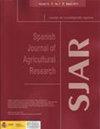Inclusion of olive by-products in growing diets causes minor effects on meat quality of Iberian pigs fattened in a traditional system
IF 0.8
4区 农林科学
Q3 AGRICULTURE, MULTIDISCIPLINARY
引用次数: 1
Abstract
Aim of study: To evaluate two experimental diets based on olive cake supplied during the growth period as an alternative to the restricted feeding applied in the production of Iberian pigs fattened with acorn (Montanera system). Area of study: Southwest of Badajoz, Spain Material and methods: 44 Iberian pigs were divided in three diet groups: 1) control (C) group (n=15), 2) dry olive pulp (DOP) group, fed a compound feed elaborated with olive pulp (n=14), and 3) wet crude olive cake (WCOC) group, fed a compound feed and olive cake silage supplied ad libitum (n=15). Subcutaneous fat biopsies were taken and backfat thickness and longissimus thoracis et lumborum (LTL) area were measured. In addition, quality traits (intramuscular fat percentage, color, pigment content, water holding capacity and shear force) were measured in LTL. Backfat fatty acid profile and intramuscular fat were also analysed. Main results: Significant differences were observed between groups for most of the fatty acids in backfat at 95 kg but differences were of lower magnitude at 160 kg and affected only to C16:1, C18:0, C18:1, C20:0, C20:1 and ΣSFA. Otherwise, lower values for red color and myoglobin content and higher for thawing water losses were observed for DOP pigs. The WCOC did not affect the analysed quality traits. Research highlights: Experimental diets did not have an important impact on growth, carcass composition or meat quality. Therefore, WCOC dietary treatment could be an interesting alternative that could reduce the undesirable effects of feed restriction.在生长日粮中加入橄榄副产品对传统系统中育肥的伊比利亚猪的肉质影响较小
研究目的:评估两种基于生长期提供的橄榄饼的实验性日粮,作为限制性饲养的替代品,用于生产用橡子育肥的伊比利亚猪(Montanera系统)。研究区域:西班牙巴达霍斯西南部材料和方法:44头伊比利亚猪被分为三个饮食组:1)对照组(C)(n=15),2)干橄榄浆(DOP)组,饲喂用橄榄浆精制的复合饲料(n=14),3)湿粗橄榄饼(WCOC)组,喂食随意供应的复合饲料和橄榄饼青贮饲料(n=15。进行皮下脂肪活检,测量背部厚度和胸腰最长肌(LTL)面积。此外,在LTL中测量质量性状(肌内脂肪百分比、颜色、色素含量、持水能力和剪切力)。还分析了脂肪脂肪酸和肌内脂肪。主要结果:在95 kg时,各组间的大多数脂肪酸存在显著差异,但在160 kg时差异较小,仅受C16:1、C18:0、C18:1、C20:0、C20:1和∑SFA的影响。否则,观察到DOP猪的红色和肌红蛋白含量较低,解冻水损失较高。WCOC不影响所分析的质量性状。研究重点:实验性饮食对生长、胴体成分或肉质没有重要影响。因此,WCOC膳食处理可能是一种有趣的替代方案,可以减少饲料限制的不良影响。
本文章由计算机程序翻译,如有差异,请以英文原文为准。
求助全文
约1分钟内获得全文
求助全文
来源期刊

Spanish Journal of Agricultural Research
农林科学-农业综合
CiteScore
2.00
自引率
0.00%
发文量
60
审稿时长
6 months
期刊介绍:
The Spanish Journal of Agricultural Research (SJAR) is a quarterly international journal that accepts research articles, reviews and short communications of content related to agriculture. Research articles and short communications must report original work not previously published in any language and not under consideration for publication elsewhere.
The main aim of SJAR is to publish papers that report research findings on the following topics: agricultural economics; agricultural engineering; agricultural environment and ecology; animal breeding, genetics and reproduction; animal health and welfare; animal production; plant breeding, genetics and genetic resources; plant physiology; plant production (field and horticultural crops); plant protection; soil science; and water management.
 求助内容:
求助内容: 应助结果提醒方式:
应助结果提醒方式:


